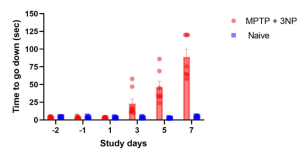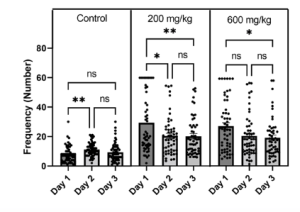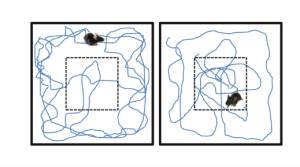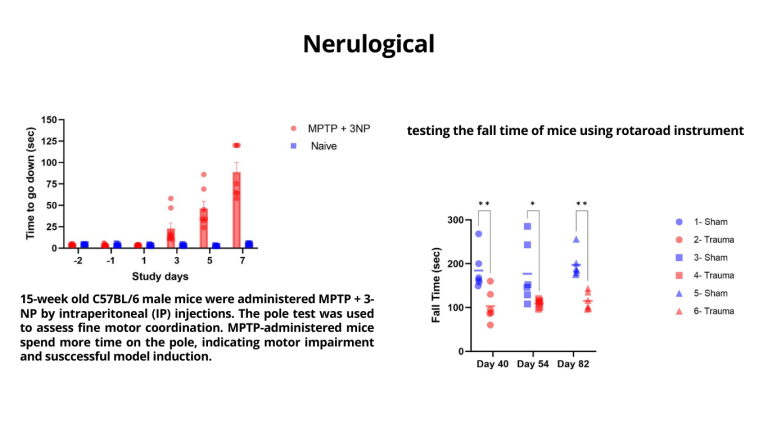Central Nervous System Models
Preclinical rodent models provide valuable insight in central nervous system (CNS) research and enable the study of pathophysiology, optimal targets, and parameters for individualized treatment. New preclinical neurosurgical models allow the targeted delivery and research of specific areas of the brain. CNS models offer the exploration of scientific frontiers in psychiatric and neurodevelopmental disorders, neurodegenerative disorders, movement disorders and epilepsy, to advance our understanding of mechanisms and improve treatment outcomes in neurological disorders.
Vivox provides expertise in developing advanced neurological models and a commitment to innovation in the field of neuroscience. Our team of highly skilled scientists, advanced technology, state-of-the-art facilities, and dedication to scientific excellence pave the path for groundbreaking discoveries in this exciting field.
The following neurological and behavioral models are available at Vivox:
Our services support a variety of therapeutic areas

Microbiome

Cell & Gene based Therapy

Biological therapy

Cannabis based therapy

Pharmaceuticals

Nutraceuticals

Medical devices
Neurological Disorder Models
Parkinson’s Disease
Parkinson’s disease (PD) is a common and severe neurodegenerative disorder, characterized by progressive motor and non-motor symptoms: tremor, rigidity, bradykinesia, executive dysfunction, concentration problems, and memory deficits.
Vivox stands out in its innovative approach to developing neurological models that accurately mimic PD pathophysiology and symptoms. We offer two murine PD models:
- 6-OHDA (6-hydroxydopamine), a highly oxidizable dopamine analogue, shows selectivity for dopaminergic neurons in the SNpc. It does not efficiently cross the BBB and requires direct intracranial injection using specialized stereotaxic surgical instruments.
- MPTP (1-methyl-4-phenyl-1,2,3,6-tetrahydropyridine), a highly lipophilic neurotoxin, rapidly crosses the blood-brain barrier (BBB) and therefore requires no surgery. We use the C57BL/6 strain, unique in its increased susceptability to the MPTP neurotoxin.
Through cutting-edge technologies and a deep understanding of neurobiology, Vivox enables researchers to study the underlying mechanisms of Parkinson’s disease, explore potential therapeutic interventions, and contribute to the advancement of its treatment strategies.

Social Interaction Test
The Social Interaction Test is a commonly used assay to evaluate anxiety-like behavior in rodents, particularly focusing on social interactions. In this test, a subject rodent is placed in a controlled environment with a novel conspecific (another rodent) to observe their social behaviors. Decreased social interactions, such as reduced time spent in social interactions or fewer approaches to the novel conspecific, represent anxiety-like behaviors and are indicative of higher anxiety levels.
Vivox employs the Social Interaction Test as part of preclinical studies to assess the anxiolytic (anti-anxiety) effects of compounds or interventions, aiding in the understanding of anxiety-related behaviors and the development of potential therapeutic strategies.
Novelty Suppressed Feeding (NSF) Test
The Novelty Suppressed Feeding (NSF) test in rats is a behavioral assay commonly used to assess anxiety-like behavior and the effects of potential anxiolytic (anti-anxiety) treatments. In this test, animals are food-deprived for a specific period (most often 24 hours), to increase their motivation to eat. Then, they are placed in an open-field arena with a novel object in the center and a food pellet in a distant corner. The time it takes for the rat to approach and consume the food pellet is measured, with longer latencies indicating higher anxiety levels.
Vivox utilizes the NSF test as part of preclinical studies to evaluate the anxiolytic effects of novel compounds or interventions, providing insights into anxiety-related behaviors and potential therapeutic strategies.
Spinal Cord Injury (SCI) Model
The spinal cord injury (SCI) model involves inducing damage to the spinal cord to mimic aspects of human spinal cord injury, through methods such as contusion, compression, or transection of the spinal cord. SCI can result in motor, sensory, and/or autonomic function deficits below the level of the injury, similar to paralysis or loss of sensation experienced by humans with spinal cord injuries.
Vivox is actively involved in SCI-oriented preclinical research, employing various animal models to study the mechanisms of injury, potential therapeutic interventions, and strategies for neural regeneration and functional recovery post-injury. It’s a valuable tool for understanding the complexities of spinal cord injury and developing treatments to improve outcomes for affected individuals.
Rotarod Test
The Rotarod test is a widely used method in preclinical research to evaluate motor coordination, balance, and motor learning in rodents. In this test, animals are placed on a rotating rod, and their ability to stay on the rod as it accelerates is measured. The time or speed at which the animal falls off or displays motor deficits provides insights into motor function and coordination.
Vivox utilizes the Rotarod test as part of preclinical assessments to evaluate the effects of compounds or interventions on motor skills and contribute to the understanding of motor-related disorders and the development of potential therapeutic interventions.

Novel Object Recognition Test (NORT)
The Novel Object Recognition Test (NORT) is a behavioral assay frequently utilized in preclinical research to evaluate recognition memory and cognitive function in rodents. In this test, animals are exposed to a familiar object and a novel object, and their preference for exploring the novel object is measured. The underlying principle is that animals naturally have a preference for exploring novel stimuli over familiar ones, reflecting their ability to recognize and remember previously encountered objects.
Vivox integrates the NORT as part of its neurobehavioral studies to assess recognition memory, and the effects of potential therapeutic interventions on cognitive function and learning processes in rodent models.
Y – Maze Test
The Y-maze is a behavioral test commonly used in preclinical research to assess spatial working memory and spontaneous alternation behavior in rodents. In this test, rodents are placed in a Y-shaped maze with three identical arms, and their spontaneous alternation behavior, which reflects their tendency to explore new arms rather than revisiting ones already explored, is measured. The percentage of spontaneous alternation is calculated, with higher values indicating better spatial working memory. Impaired performance can indicate deficits in spatial memory and executive function.
Vivox incorporates the Y-maze test as part of neurobehavioral studies to assess cognitive function, memory retention, and the effects of potential therapeutic interventions on learning and memory processes in rodent models.
Vivox integrates the NORT as part of its neurobehavioral studies to assess recognition memory, and the effects of potential therapeutic interventions on cognitive function and learning processes in rodent models.

Morris Water Maze Test
The Morris water maze test is a widely used behavioral test to assess spatial learning and memory in rodents, particularly rats. In this test, animals are placed in a large pool of water with a hidden platform submerged beneath the water’s surface. The animals must learn and remember the platform’s location based on visual cues in the environment to escape from the water. Over several trials, researchers measure the time it takes for the animals to find the platform (latency), their swimming paths, and their ability to remember the platform’s location in subsequent trials.
Vivox employs the Morris water maze test as part of preclinical studies to evaluate cognitive function, spatial memory, and the effects of potential therapeutic interventions on learning and memory processes.

Elevated Plus Maze (EPM) Test
The Elevated Plus Maze (EPM) test is a widely used behavioral test in preclinical research for assessing anxiety-like behavior in rodents. The maze is plus-shaped and consists of two open arms and two enclosed arms elevated above the ground. Animals are placed on the center platform and allowed to freely explore the maze. The time spent in and entries into the open and closed arms are recorded, along with other behaviors such as grooming and freezing. Increased time spent in the open arms is considered an indicator of reduced anxiety-like behavior, while decreased time suggests heightened anxiety.
Vivox has expertise in utilizing the EPM test, which enables detailed investigation into anxiety-related behaviors, stress responses, and the effects of potential anxiolytic therapies, contributing to advancements in behavioral neuroscience and psychiatric research.
Open Field Test
The open field test is a standard method used to assess exploratory behavior and locomotion as measures of anxiety-like behavior in mice and rats. In this test, animals are placed in an open arena, and their movements are tracked and recorded over a specific period. Parameters such as total distance traveled, time spent in the center versus periphery of the arena, and rearing behavior are analyzed to evaluate the animal’s activity level, exploratory behavior, and thus anxiety levels.
Vivox incorporates the open field test in preclinical studies to assess the effects of compounds or interventions on locomotor activity and anxiety-related behaviors, providing valuable insights into neurological function and potential therapeutic interventions.
Lesion-Induced (LI) Schizophrenia Model
The LI schizophrenia model was developed to evaluate for negative symptoms in Schizophrenia. It is a valuable tool in preclinical research for studying aspects related to diminished emotional expression, social withdrawal, and cognitive deficits. The LI model involves inducing brain lesions, typically in regions associated with negative symptoms, to mimic certain aspects of the disorder in animal models. By assessing behavior, cognitive function, and neurobiological changes following lesion induction, researchers can gain insights into the underlying mechanisms of negative symptoms in schizophrenia.
Vivox’s expertise in utilizing the LI schizophrenia model to enable detailed investigation into the pathophysiology of negative symptoms and the development of potential interventions targeting these specific aspects of schizophrenia, contributing to advancements in psychiatric research and therapeutic strategies.
Micro implantation/infusion pumps for continuous intracranial drug delivery
Optic nerve dissection, brain target labeling, virus vector intracranial injection
IVIS monitoring for brain integrity and BBB permeability
CSF sampling and intrathecal injection
Neurotoxin-induced Alzheimer’s disease and epilepsy models
ALS –SOD1-G93A transgenic mice express a mutant form of human SOD1
Global cerebral ischemia, chronic cerebral ischemia, ischemic and hemorrhagic stroke and dementia models
Research outcomes - examples

